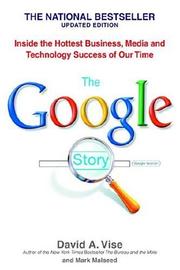| Listing 1 - 10 of 25 | << page >> |
Sort by
|
Book
ISBN: 1949449440 Year: 2019 Publisher: New York : Momentum Press, LLC,
Abstract | Keywords | Export | Availability | Bookmark
 Loading...
Loading...Choose an application
- Reference Manager
- EndNote
- RefWorks (Direct export to RefWorks)
Book
ISBN: 1783989416 Year: 2015 Publisher: Birmingham : Packt Publishing,
Abstract | Keywords | Export | Availability | Bookmark
 Loading...
Loading...Choose an application
- Reference Manager
- EndNote
- RefWorks (Direct export to RefWorks)
Book
ISBN: 1280277920 9786610277926 0471769053 Year: 2005 Publisher: Indianapolis, Indiana : Wiley Publishing, Inc.,
Abstract | Keywords | Export | Availability | Bookmark
 Loading...
Loading...Choose an application
- Reference Manager
- EndNote
- RefWorks (Direct export to RefWorks)

ISBN: 0596001622 9780596001629 Year: 2004 Publisher: Sebastopol, CA: O'Reilly,
Abstract | Keywords | Export | Availability | Bookmark
 Loading...
Loading...Choose an application
- Reference Manager
- EndNote
- RefWorks (Direct export to RefWorks)
Cache memory. --- Browsers (Computer programs) --- Web servers.
Book
Year: 2022 Publisher: New York, New York : Association for Computing Machinery,
Abstract | Keywords | Export | Availability | Bookmark
 Loading...
Loading...Choose an application
- Reference Manager
- EndNote
- RefWorks (Direct export to RefWorks)

ISBN: 0553383663 9780553383669 Year: 2005 Publisher: New York Delta
Abstract | Keywords | Export | Availability | Bookmark
 Loading...
Loading...Choose an application
- Reference Manager
- EndNote
- RefWorks (Direct export to RefWorks)
Browsers (Computer programs) --- Entrepreneurship --- Google (Firm)
Book
ISBN: 9786613177964 9781119994787 1119994780 9781283177962 128317796X 9781119994794 1119994799 Year: 2011 Publisher: Chichester, U.K. : Wiley,
Abstract | Keywords | Export | Availability | Bookmark
 Loading...
Loading...Choose an application
- Reference Manager
- EndNote
- RefWorks (Direct export to RefWorks)
Create amazing mobile augmented reality apps with junaio, Layar, and Wikitude! Professional Augmented Reality Browsers for Smartphones guides you through creating your own augmented reality apps for the iPhone, Android, Symbian, and bada platforms, featuring fully workable and downloadable source code. You will learn important techniques through hands-on applications, and you will build on those skills as the book progresses. Professional Augmented Reality Browsers for Smartphones: Describes how to use the latitude/longitude coordinate system to build
Augmented reality. --- Smartphones --- Browsers (Computer programs) --- Programming.
Book
ISBN: 0440335701 1299070566 Year: 2005 Publisher: New York : Delacorte Press,
Abstract | Keywords | Export | Availability | Bookmark
 Loading...
Loading...Choose an application
- Reference Manager
- EndNote
- RefWorks (Direct export to RefWorks)
In 1998, Moscow-born Sergey Brin and Midwest-born Larry Page dropped out of graduate school at Stanford University to, in their own words, "change the world" through a search engine that would organize every bit of information on the Web for free. While the company has done exactly that, Google's quest continues as it seeks to add millions of library books, television broadcasts, and more to its searchable database. Readers will learn about the business acumen and computer wizardry that started the company on its astonishing course; the secret network of computers delivering lightning-fast search results; the unorthodox approach that has enabled it to challenge Microsoft's dominance and shake up Wall Street. Even as it rides high, Google wrestles with difficult choices that will enable it to continue expanding while sustaining the guiding vision of its founders' mantra: Do no evil.--From publisher description.
Browsers (Computer programs) --- Entrepreneurship --- Google (Firm)
Multi
ISBN: 9781484287255 9781484287248 9781484287262 9781484299081 1484287258 Year: 2023 Publisher: Berkeley, CA : Apress : Imprint: Apress,
Abstract | Keywords | Export | Availability | Bookmark
 Loading...
Loading...Choose an application
- Reference Manager
- EndNote
- RefWorks (Direct export to RefWorks)
Web developers today have plenty of experience with building regular web page apps, but a lot of that knowledge doesn't transfer over when it comes to creating browser extensions. This book provides a complete reference for how to build modern browser extensions. Creating and deploying a browser extension is more like building a mobile app than a website. When you start building an extension, you'll often find there are a large number of new concepts and idiosyncrasies to wrangle with. This book reveals how to successfully navigate around these obstacles and how to take advantage of the limited resources available. You'll see how a browser extensions work, their component pieces, and how to build and deploy them. Additionally, you'll review all the tricky bits of extension development that most developers have to learn through trial and error. The current transition from manifest v2 to v3 is of special interest, and an entire chapter is dedicated to this subject. By the end of this book, you will have a rich understanding of what browser extensions are, how they work, all the pitfalls to avoid, and the most efficient ways of building them. You will: Examine the different components of browser extensions and how they behave How to use all the latest extension APIs and features Review common pitfalls developers encounter when building browser extensions and how to avoid them Develop, deploy, and manage a published browser extension Build a browser extension using modern JavaScript frameworksScript frameworks.
Computer. Automation --- websites --- Browsers (Computer programs) --- Application software --- Development.
Book
ISBN: 9781593273880 Year: 2012 Publisher: San Francisco No Starch Press
Abstract | Keywords | Export | Availability | Bookmark
 Loading...
Loading...Choose an application
- Reference Manager
- EndNote
- RefWorks (Direct export to RefWorks)
"'Thorough and comprehensive coverage from one of the foremost experts in browser security.' --Tavis Ormandy, Google Inc. Modern web applications are built on a tangle of technologies that have been developed over time and then haphazardly pieced together. Every piece of the web application stack, from HTTP requests to browser-side scripts, comes with important yet subtle security consequences. To keep users safe, it is essential for developers to confidently navigate this landscape.In The Tangled Web, Michal Zalewski, one of the world's top browser security experts, offers a compelling narrative that explains exactly how browsers work and why they're fundamentally insecure. Rather than dispense simplistic advice on vulnerabilities, Zalewski examines the entire browser security model, revealing weak points and providing crucial information for shoring up web application security. You'll learn how to: Perform common but surprisingly complex tasks such as URL parsing and HTML sanitization Use modern security features like Strict Transport Security, CSP, and CORS Leverage many variants of the same-origin policy to safely compartmentalize complex web applications and protect user credentials in case of XSS bugs Build mashups and embed gadgets without getting stung by the tricky frame navigation policy Embed or host user-supplied content without running into the trap of content sniffing For quick reference, "Security Engineering Cheat Sheets' at the end of each chapter offer ready solutions to problems you're most likely to encounter. With coverage extending as far as planned HTML5 features, The Tangled Web will help you create secure web applications to stand the test of time"--
Browsers (Computer programs) --- Computer networks --- Computer security --- Security measures
| Listing 1 - 10 of 25 | << page >> |
Sort by
|

 Search
Search Feedback
Feedback About UniCat
About UniCat  Help
Help News
News